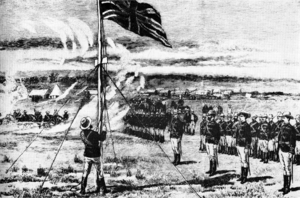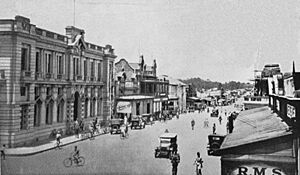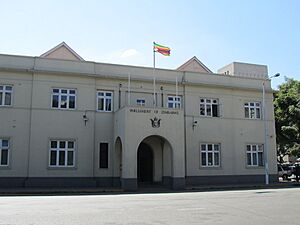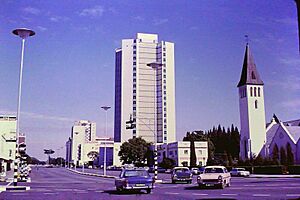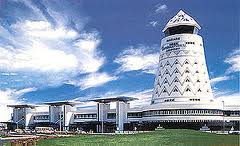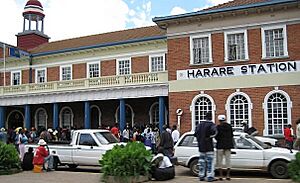Harare facts for kids
Quick facts for kids
Harare
|
|||
|---|---|---|---|
|
Capital city and province
|
|||
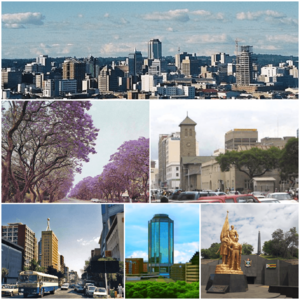
Left to right, from top: Harare skyline; Jacaranda trees lining Josiah Chinamano Avenue; Old Parliament House (front) and the Anglican Cathedral (behind); downtown Harare; New Reserve Bank Tower; Heroes' Acre monument
|
|||
|
|||
| Nicknames:
Sunshine City, H Town
|
|||
Motto(s):
|
|||
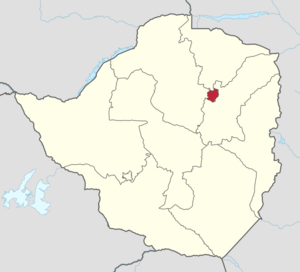
Location of Harare Province in Zimbabwe
|
|||
| Country | Zimbabwe | ||
| Province | Harare | ||
| Founded | 12 September 1890 | ||
| Incorporated (city) | 1935 | ||
| Renamed Harare | 18 April 1982 | ||
| Government | |||
| • Type | Mayor–council | ||
| Area | |||
| • Capital city and province | 982.3 km2 (379.3 sq mi) | ||
| Elevation | 1,490 m (4,890 ft) | ||
| Population
(2022 census)
|
|||
| • Capital city and province | 1,491,740 | ||
| • Density | 1,518.62/km2 (3,933.21/sq mi) | ||
| • Urban | 1,558,823 | ||
| • Metro | 1,603,201 | ||
| Demonym(s) | Hararean | ||
| Time zone | UTC+02:00 (Central Africa Time) | ||
| • Summer (DST) | (Not Observed) | ||
| Area code(s) | 242 | ||
| HDI (2018) | 0.645 Medium |
||
| Dialling code 242 (or 0242 from within Zimbabwe) | |||
Harare (/həˈrɑːreɪ/ hə-RAR-ay), once called Salisbury, is the capital and largest city of Zimbabwe. The city itself covers about 982.3 square kilometers. In 2022, its population was around 1.85 million people. The wider metropolitan area has an estimated 2.49 million residents.
Harare is located in the northeastern part of Zimbabwe, in the Mashonaland region. It's a metropolitan province that includes nearby towns like Chitungwiza and Epworth. The city sits on a high plateau about 1,483 meters above sea level. This high location gives it a cool, subtropical highland climate.
The city was started in 1890 by a group of settlers called the Pioneer Column. They were part of the British South Africa Company. They first named it Fort Salisbury after the British Prime Minister, Lord Salisbury. The city was managed by the company until 1923 when Southern Rhodesia gained self-governance. Salisbury then became the capital. From 1953 to 1963, it was also the capital of the Federation of Rhodesia and Nyasaland. The city kept the name Salisbury until 1982. It was renamed Harare on April 18, 1982, two years after Zimbabwe became independent from the United Kingdom.
Harare is Zimbabwe's main business center. Even with some economic challenges, it's still very important for commerce, government, and finance. It also plays a key role in real estate, manufacturing, healthcare, education, art, culture, tourism, agriculture, and mining. Harare has many embassies, making it a hub for international relations in Southern Africa. It also hosts the African headquarters for the World Health Organization.
The city has hosted big international events, like the 1995 All-Africa Games and some matches for the 2003 Cricket World Cup. In 2018, Harare was recognized as a Gamma World City, meaning it's an important global city. It's also home to Dynamos F.C., one of Zimbabwe's most successful football clubs.
Contents
History of Harare
How Harare Began
The city was founded as a fort on September 12, 1890, by the Pioneer Column. This was a group of military volunteers led by Cecil Rhodes. They named it Fort Salisbury after the British Prime Minister, The 3rd Marquess of Salisbury. Later, it was just called Salisbury. The city became a municipality in 1897 and a full city in 1935.
When the city was first built, the land was quite wet. The first buildings were put on higher ground near a stream. This area is now where the Julius Nyerere Way industrial road is. The first area to be properly drained was called Causeway. Today, many important government buildings, like the Senate House, are located there.
Salisbury became the capital of the self-governing British colony of Southern Rhodesia in 1923.
Growth After World War II
After the Second World War, Salisbury grew very quickly. This was especially true when it became the capital of the Federation of Rhodesia and Nyasaland from 1953 to 1963. During this time, many new buildings were constructed, changing the city's look. Many white people, mainly from Great Britain and Southern Africa, moved to the city.
More people started owning cars, and new roads were built. This led to new suburbs like Alexandra Park and Mount Pleasant spreading out. At the same time, mostly black suburbs like Highfield became very crowded as their populations grew.
Changes in the 1960s and 1970s
The Federation of Rhodesia and Nyasaland ended in 1963. On November 11, 1965, the government of Ian Smith declared Rhodesia independent from the United Kingdom. Salisbury remained the capital. Rhodesia later became the state of Zimbabwe Rhodesia. Finally, on April 18, 1980, the country was internationally recognized as the independent Republic of Zimbabwe.
After Independence
After Zimbabwe gained independence in 1980, the city saw a lot of hope and new investments. On April 18, 1982, the city's name was changed to Harare. This new name came from a village near Harare Kopje, named after the Shona chief Neharawa. His nickname meant "he who does not sleep." Before independence, "Harare" was the name of the black residential area now known as Mbare.
There was a lot of investment in education and healthcare. This helped a confident middle class grow. New companies like Econet Global started, and buildings like the Eastgate Centre showed off new designs. The New Reserve Bank Tower is a famous landmark from this time.
Harare hosted important international meetings, like the 8th Summit of the Non-Aligned Movement in 1986. It also hosted the Commonwealth Heads of Government Meeting 1991, which created the Harare Declaration about joining the Commonwealth.
However, by 1992, Harare's economy started to slow down. The government tried new economic policies. These policies helped banking and agriculture, but many jobs were lost in manufacturing. This led to more unemployment and a bigger gap between rich and poor. Local businesses found it hard to compete with foreign goods, and some industries, like textiles, struggled.
Economic Challenges (1999–2008)
In the early 2000s, Harare faced big economic problems that affected all of Zimbabwe. Essential services like trash collection and street repairs got much worse, especially in poorer areas. In 2009 and 2011, Harare was ranked as one of the toughest cities to live in by the Economist Intelligence Unit. This ranking looked at things like stability, healthcare, culture, environment, education, and infrastructure.
Operation Murambatsvina
In May 2005, the Zimbabwean government tore down many informal settlements and vending sites in Harare and other cities. This was called Operation Murambatsvina, which means "Drive Out Trash." The government said this was to stop crime and disease. Later, they started Operation Garikayi/Hlalani Kuhle ("Better Living") to build simple concrete houses.
Recent Economic Situation
In March 2010, Harare's Joina City Tower finally opened after many years of delays. It was called 'Harare's New Pride'. In 2011, the Economist Intelligence Unit still ranked Harare as one of the least livable cities in the world.
In 2017, a very large protest happened in Harare. This led to the resignation of long-serving President Robert Mugabe. This event was part of the first successful coup in Zimbabwe.
Modern Harare
Since 2000, Harare has seen periods of decline, especially in the early 2000s. But since the Great Recession, things have become more stable. The city has grown a lot in population and has seen some economic growth. There has been a lot of international investment in the city's financial and property markets.
New developments have spread to the edges of the city in areas like Borrowdale and Glen Lorne. Older areas like Avondale have also seen improvements, with new people moving in and property prices going up. Harare has had the biggest population increase and urban growth of any major Zimbabwean city since 2000.
Harare's property market is still very expensive, even more so than cities like Johannesburg and Cape Town. Wealthy Zimbabweans living abroad, Chinese, and South African buyers mostly drive this market. Even with these changes, unemployment rates in the city and country remain high.
In 2020, Harare was classified as a Gamma city by the Globalization and World Cities Research Network. This means it's an important city in the global network.
People of Harare
As of 2012, Harare had a population of about 2.1 million people. Most people in Harare, over 90%, are Shona-speaking people of African descent. Many Ndebele and Kalanga people also live in Harare. About 25,000 white Zimbabweans live in the Harare area too.
Geography and Layout
Where is Harare Located?
The city is located on a high part of the Highveld plateau in Zimbabwe, about 1,483 meters above sea level. The land was originally like a "parkland" with wild spaces. The soil in Harare varies. In the north and center, it's mostly reddish-brown clay. In the south, it's gray-brown sand over lighter, sandy soil.
City Areas and Suburbs
The City of Harare is divided into different suburbs. Outside the city, there are independent towns like Epworth and Chitungwiza, which are still part of the larger metropolitan province.
The central business district (CBD) of Harare has wide streets and a mix of old and new buildings. In downtown Harare, you can find places like Africa Unity Square, the Harare Gardens, the National Gallery, and the Parliament buildings. Causeway, a part of central Harare, is a busy area where many embassies and international organizations are located. Many government offices and museums, like the Zimbabwe Museum of Human Sciences, are also here.
Rotten Row is a sub-district in downtown Harare. It's known as Harare's legal area, home to the Harare Magistrate's Court and many law offices.
The northern and northeastern suburbs of Harare are generally where wealthier residents live. These areas often have names ending in "-dale," like Avondale and Borrowdale. Homes here are usually large, with three or more bedrooms, and are often occupied by families. Emerald Hill in the northwest is named for its green, tree-covered hills and its Irish connections.
To the east of the city center, you'll find suburbs like Arcadia and Newlands. Arlington is a newer suburb near Harare International Airport.
The southern parts of Harare have historically been more industrial. These areas were often home to most of the African population and some lower-income European residents. Highfield, started in 1930, is one of the oldest high-density suburbs. It was created for black workers who provided labor for the industrial areas of Southerton and Workington.
Climate of Harare

Harare has a subtropical highland climate. Because the city is on a plateau, its high altitude and cool winds make its climate cooler and drier than typical tropical or subtropical areas.
The average yearly temperature is about 17.95°C. This is quite low for a tropical region.
There are three main seasons:
- A warm, wet summer from November to March/April.
- A cool, dry winter from May to August (like winter in the Southern Hemisphere).
- A warm to hot, dry season in September/October.
Temperatures usually range from 7°C to 22°C in July (the coldest month). In October (the hottest month), they range from 15°C to 29°C. In January (midsummer), they are about 16°C to 26°C.
The average yearly rainfall is about 825 mm in the southwest and 855 mm in the northeast. Very little rain falls from May to September. Rainfall can vary a lot from year to year.
The climate supports open woodlands. The most common local tree is the msasa, whose wine-red leaves are very noticeable in late August. Two introduced trees, the jacaranda and the flamboyant, add beautiful lilac and red blossoms to the city in October/November. Bougainvillea is also common.
| Climate data for Harare (1961–1990, extremes 1897–present) | |||||||||||||
|---|---|---|---|---|---|---|---|---|---|---|---|---|---|
| Month | Jan | Feb | Mar | Apr | May | Jun | Jul | Aug | Sep | Oct | Nov | Dec | Year |
| Record high °C (°F) | 33.9 (93.0) |
35.0 (95.0) |
32.3 (90.1) |
32.0 (89.6) |
30.0 (86.0) |
27.7 (81.9) |
28.8 (83.8) |
31.0 (87.8) |
35.0 (95.0) |
36.7 (98.1) |
35.3 (95.5) |
33.5 (92.3) |
36.7 (98.1) |
| Mean daily maximum °C (°F) | 26.2 (79.2) |
26.0 (78.8) |
26.2 (79.2) |
25.6 (78.1) |
23.8 (74.8) |
21.8 (71.2) |
21.6 (70.9) |
24.1 (75.4) |
28.4 (83.1) |
28.8 (83.8) |
27.6 (81.7) |
26.3 (79.3) |
25.5 (77.9) |
| Daily mean °C (°F) | 21.0 (69.8) |
20.7 (69.3) |
20.3 (68.5) |
18.8 (65.8) |
16.1 (61.0) |
13.7 (56.7) |
13.4 (56.1) |
15.5 (59.9) |
18.6 (65.5) |
20.8 (69.4) |
21.2 (70.2) |
20.9 (69.6) |
18.4 (65.1) |
| Mean daily minimum °C (°F) | 15.8 (60.4) |
15.7 (60.3) |
14.5 (58.1) |
12.5 (54.5) |
9.3 (48.7) |
6.8 (44.2) |
6.5 (43.7) |
8.5 (47.3) |
11.7 (53.1) |
14.5 (58.1) |
15.5 (59.9) |
15.8 (60.4) |
12.3 (54.1) |
| Record low °C (°F) | 9.6 (49.3) |
8.0 (46.4) |
7.5 (45.5) |
4.7 (40.5) |
2.8 (37.0) |
0.1 (32.2) |
0.1 (32.2) |
1.1 (34.0) |
4.1 (39.4) |
5.1 (41.2) |
6.1 (43.0) |
10.0 (50.0) |
0.1 (32.2) |
| Average precipitation mm (inches) | 190.8 (7.51) |
176.3 (6.94) |
99.1 (3.90) |
37.2 (1.46) |
7.4 (0.29) |
1.8 (0.07) |
2.3 (0.09) |
2.9 (0.11) |
6.5 (0.26) |
40.4 (1.59) |
93.2 (3.67) |
182.7 (7.19) |
840.6 (33.09) |
| Average precipitation days | 17 | 14 | 10 | 5 | 2 | 1 | 0 | 1 | 1 | 5 | 10 | 16 | 82 |
| Average relative humidity (%) | 76 | 77 | 72 | 67 | 62 | 60 | 55 | 50 | 45 | 48 | 63 | 73 | 62 |
| Mean monthly sunshine hours | 217.0 | 190.4 | 232.5 | 249.0 | 269.7 | 264.0 | 279.0 | 300.7 | 294.0 | 285.2 | 231.0 | 198.4 | 3,010.9 |
| Mean daily sunshine hours | 7.0 | 6.8 | 7.5 | 8.3 | 8.7 | 8.8 | 9.0 | 9.7 | 9.8 | 9.2 | 7.7 | 6.4 | 8.2 |
| Source 1: World Meteorological Organization, NOAA (sun and mean temperature, 1961–1990), | |||||||||||||
| Source 2: Deutscher Wetterdienst (humidity, 1954–1975), Meteo Climat (record highs and lows) | |||||||||||||
Economy of Harare
Harare is Zimbabwe's main center for finance, commerce, and communications. It's also a global trading hub for products like tobacco, maize, cotton, and citrus fruits. Making things like textiles, steel, and chemicals is also important for the economy. Trading precious minerals such as gold, diamonds, and platinum also adds to the economy.
In the early 2000s and 2010s, Harare saw a big boom in real estate, especially in the wealthy northern suburbs. Property prices went up a lot. This was partly because Zimbabweans living abroad invested their money, hoping to protect it from local currency changes. However, this growth has slowed down recently due to higher interest rates and the effects of the COVID-19 pandemic.
One challenge for Harare's economy is that many highly educated and skilled people are moving to other countries. This "brain drain" means there are fewer local business owners and a shrinking middle class. It also means fewer job opportunities outside of informal work and government jobs. However, even after years of challenges, the city's buildings and skilled workforce are still good compared to many other African and Latin American cities.
Shopping and Retail
You can buy local art, handicrafts, and souvenirs at places like Doon Estate, Uwminsdale, Avondale Market, and Mbare Musika. Msasa Park and Umwinsdale have many galleries that sell beautiful Shona stone sculptures and textiles. International brands are less common than in European cities. However, you can find regular and luxury shopping at places like Fife Avenue, Sam Nujoma Avenue, Arundel Village, Avondale, Borrowdale, Eastgate, and Westgate. Most luxury shopping is in the wealthier northern suburbs, especially Borrowdale.
Getting Around Harare
Harare is a relatively new city that grew a lot after the country's independence. It was also separated by race and class until 1976. Because of this, Harare is a spread-out city designed for people with private cars. It doesn't have a very good public transportation system. Not much money has been invested in creating a good public transport network. This means many people rely on informal minibus taxis. Recently, local ridesharing apps like GTaxi and Hwindi have helped, but they are still too expensive for most working people. Bus services are available, but they are mostly for traveling between cities, not within Harare itself.
The city's public transport includes government-run ZUPCO buses. There are also private minibuses, officially called 'commuter omnibuses'. Harare has two types of taxis: metered taxis (which you usually have to call) and share taxis or 'kombis' (which are very common). The minibus taxis are the main way most people in Harare get around every day.
As of May 2023, Harare does not have any passenger train service. The National Railways of Zimbabwe used to run daily overnight passenger trains to Mutare and Bulawayo. These services stopped in 2020 due to the COVID-19 pandemic. Commuter train routes in Harare also ran from 2001 to 2006 and were briefly brought back in 2021, but stopped again in 2022.
Long-distance bus services connect Harare to most other parts of Zimbabwe.
The city is part of Transafrican Highway 9 (TAH 9), which links it to Lusaka and Beira.
The largest airport in Zimbabwe, the Robert Gabriel Mugabe International Airport, serves Harare.
Education in Harare
The University of Zimbabwe is located in Harare. It was founded in 1952 and is the country's oldest and largest university. It offers many different programs for students. It has over 20,000 students, including undergraduate and postgraduate students.
Sports in Harare

Harare is known as Zimbabwe's sporting capital. It helps develop sports, hosts many events, and has great venues. More professional sports teams in Harare compete nationally and internationally than in any other Zimbabwean city. Football is the most popular sport, especially among working-class residents. Many footballers from Harare have gone on to play in the English Premier League and other leagues. Cricket and rugby are also popular, especially with middle-class people.
In 1995, Harare hosted most of the sixth All-Africa Games. It also hosted some matches for the 2003 Cricket World Cup. In March 2018, Harare hosted the ICC Cricket 2018 World Cup Qualifier matches.
Harare is home to the Harare Sports Club Ground, where many international cricket matches are played. The Zimbabwe Premier Soccer League clubs Dynamos F.C., Black Rhinos F.C., and CAPS United F.C. are also based in the city. Harare's main stadiums are the National Sports Stadium and Rufaro Stadium.
Popular Sports Teams
Here are some of the major sports teams in the Harare area:
| Club | Sport | League | Founded | Venue | Capacity |
|---|---|---|---|---|---|
| Dynamos F.C. | Association football | ZPSL | 1963 | Rufaro Stadium (Mbare, Harare) |
40,00 |
| CAPS United F.C. | Association football | ZPSL | 1973 | National Sports Stadium (Harare) |
60,000 |
| Old Georgians | Rugby Union | SSRL | 1926 | Harare Sports Club | 10,000 |
| Old Hararians | Rugby Union | SSRL | 1898 | Harare Sports Club | 10,000 |
| Black Rhinos F.C. | Association football | ZPSL | 1983 | Figaro Stadium | 17,544 |
| Mashonaland Eagles | Cricket | Logan Cup | 2009 | Harare Sports club | 10,000 |
| Old Miltonians | Rugby Union | SSRL | 1910 | Harare Sports Club | 10,000 |
Football and Cricket The main football stadiums in Harare are the National Sports Stadium and Rufaro Stadium.
Almost all major cricket matches are held at Harare Sports Club. This city is also home to the Mashonaland Eagles cricket team, which plays in the domestic Logan Cup tournament. The Eagles are one of the country's strongest teams.
Rugby Harare is also a major center for rugby union in Zimbabwe. The Zimbabwe Rugby Union is based in Harare. The city is home to four of the country's top rugby clubs: Harare Sports Club, Old Georgians, Old Hararians, and Old Miltonians. International rugby matches are often held at Harare Sports Club and the Police Grounds.
High school rugby teams in Harare are very good. Schools like Prince Edward School, St. George's College, and St. John's College often compete against well-known South African high schools. After high school, many talented players from Harare move to South Africa or the United Kingdom to play professionally or for better opportunities.
Media in Harare
Harare is home to some of Zimbabwe's main media outlets. Even with some government control, the city has a strong press. Many newspapers are critical of the government. The most famous newspaper is The Herald, which started in 1893. It was known for heavy censorship during the Rhodesian Front government. Today, it is often seen as supporting the government.
However, private newspapers are more independent and have many readers. These include the Financial Gazette, known for its pink paper, and the Zimbabwe Independent, which is known for its investigative journalism. Other newspapers are the Standard, NewsDay, H-Metro, the Daily News, and Kwayedza, the main Shona language newspaper.
Online news sources include ZimOnline, ZimDaily, the Zimbabwe Guardian, and NewZimbabwe.com.
Television and Radio
The state-owned ZBC TV is the only free-to-air TV channel in the city. Because of this, many households that can afford it subscribe to satellite TV services like DStv for entertainment, news, and sports from around the world.
In November 2021, it was announced that six new private TV stations would start broadcasting in Zimbabwe. This ended the 64-year monopoly of the state-owned broadcaster. These new channels include Zimpapers Television Network, NRTV, 3K TV, Kumba TV, Ke Yona TV, and Channel Dzimbahwe.
Harare also has many radio stations. There are four state-controlled channels (SFM, Radio Zimbabwe, Power FM, and National FM). There are also private national stations like Star FM, Capital 100.4 FM, and ZiFM. Most broadcasts are in English, Shona, and Ndebele.
Places to Visit
Harare has a lively cultural and art scene. Artists often use their work to respond to economic and political issues. Theatre and art have become very active since 2000, with actors, directors, and artists joining musicians and writers in criticizing political problems. This has made the local art scene one of the most vibrant in the Southern Hemisphere.
The city also hosts the Harare International Festival of the Arts (HIFA).
Harare has several important museums and monuments. The National Gallery of Zimbabwe displays Shona art and stone sculptures. The Zimbabwe Museum of Human Sciences shows the history of Southern Africa from the Stone Age to the Iron Age. You can find old artifacts, newspapers, and other historical items at the National Archives. The Heroes' Acre is a national monument and burial ground. It honors fighters from the Rhodesian Bush War and other Zimbabweans who have served their country.
Private art places include Chapungu Sculpture Park in Msasa Park. It shows the work of Zimbabwean stone sculptors. A famous building in Harare is the Eastgate Centre, a shopping mall with a unique design.
Green Spaces
Harare is nicknamed "Sunshine City" because it has many parks and outdoor areas. There are lots of parks and gardens throughout the city, many close to the main business district. They have a variety of common and rare plants, beautiful landscapes, walking paths, and tree-lined streets. Harare's parks are often considered the best public parks in Zimbabwe's major cities. There are also many parks in the suburbs, especially in wealthy areas like Borrowdale and Mount Pleasant.
Important green spaces within the city include:
- The National Botanical Gardens in Alexandra Park. It grows plants from Southern Africa in woodland habitats.
- The Royal Harare Golf Course, an 18-hole golf course set in woodland. It hosts the Zimbabwe Open each year.
- Cleveland Dam Recreational Park, which overlooks the Cleveland Dam.
- Mukuvisi Woodlands, a large area of native woodland. It's home to zebras, giraffes, and other animals, as well as many birds and plants.
Other places near Harare include Lake Chivero Dam and Recreational Park, Epworth's Balancing Rocks, Ewanrigg Botanical Gardens, Domboshava National Monument, Lion and Cheetah Park, and Vaughn Animal Sanctuary.
Places of Worship
Most places of worship in Harare are Christian churches and temples. Some of the Christian groups in Harare include: Assemblies of God, Baptist Convention of Zimbabwe, Reformed Church in Zimbabwe, Church of the Province of Central Africa (Anglican), and the Roman Catholic Archdiocese of Harare.
Sister Cities
Harare has special agreements or "sister city" relationships with these towns:
 Cincinnati, United States
Cincinnati, United States Guangzhou, China
Guangzhou, China Kazan, Russia
Kazan, Russia Lago, Italy
Lago, Italy Maputo, Mozambique
Maputo, Mozambique Munich, Germany
Munich, Germany Nakhon Ratchasima, Thailand
Nakhon Ratchasima, Thailand Nottingham, United Kingdom
Nottingham, United Kingdom Prato, Italy
Prato, Italy Windhoek, Namibia
Windhoek, Namibia
Images for kids
See also
 In Spanish: Harare para niños
In Spanish: Harare para niños





